Effective Strategies to Remove Pet Urine Odor from Hardwood Floors
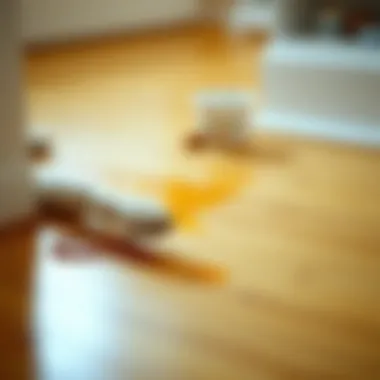
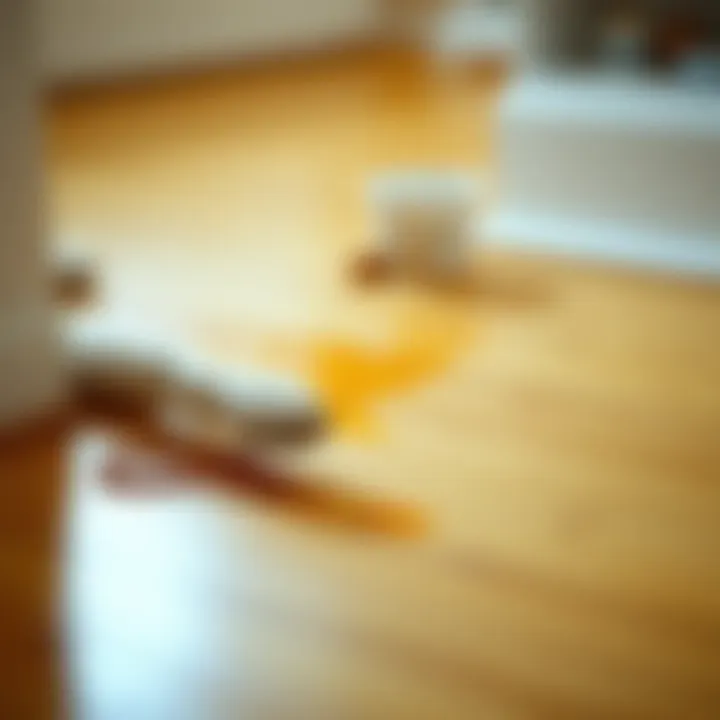
Intro
Pet ownership brings immeasurable joy, but it also comes with its fair share of challenges, one of which includes managing unpleasant odors from pets. For many pet owners, maintaining a fresh home can feel like a never-ending battle, especially when dealing with pet urine stains on hardwood floors.
Wooden flooring, while aesthetically pleasing, is notoriously tricky when it comes to cleaning. The porous nature of wood allows urine to seep in, creating persistent odors that can linger long after the stain has been wiped away. Understanding the chemistry behind pet urine and developing effective cleaning strategies can make a world of difference.
In this article, we aim to equip pet owners with effective methods for eliminating these stubborn odors and avoiding future mishaps. We will delve into the intricacies of urine stains, the optimal cleaning techniques, and even preventive measures that can help safeguard your enticing wooden floors.
By applying the right knowledge and strategies, together we can create a harmonious living environment that prioritizes the well-being of both your furry companions and the humans who love them.
Understanding the Problem
When it comes to living with pets, one of the most persistent issues pet owners face is the odor caused by pet urine, especially on hardwood floors. The significance of understanding this problem cannot be overstated, as it helps in devising effective strategies to manage the smell and preserve the integrity of the flooring. This problem isn’t just a nuisance; it affects the entire living environment and can even impact health. If left untreated, the odor can lead to more severe issues, including damage to the wood itself, which may require costly repairs or replacements.
Understanding the chemistry of pet urine and how it interacts with hardwood floors is crucial for any pet owner. It equips individuals with the knowledge needed not only to tackle existing stains and odors but also to prevent future occurrences. Addressing this issue begins with recognizing the chemistry behind the problem, allowing for informed decisions regarding cleaning methods and preventive measures.
By knowing what pet urine is composed of and how it behaves when it seeps into wood, pet owners can select the most effective cleaning solutions. Additionally, understanding how urine affects the structural integrity of hardwood floors can make a distinction between a simple cleaning task and a formidable renovation project. Recognizing the potential damage that can arise from overlooked urine spots encourages regular maintenance practices that help ensure the home remains a pleasant space for both pets and humans alike.
In essence, being proactive and well-informed on this issue lays the groundwork for a healthier home environment, showcasing the bond between humans and their pets as one that values both cleanliness and care.
The Chemistry of Pet Urine
Pet urine is more complex than one might think. It contains a mixture of water, urea, creatinine, uric acid, various salts, and other substances. Water constitutes the bulk of urine, generally around 95%, but that remaining 5% carries a significant punch in terms of odor. Uric acid is a primary component that can cling to surfaces and is notoriously difficult to neutralize. This compound isn’t just smelly; when it dries, it forms crystals that can penetrate the hardwood’s pores, making cleanup a more arduous task.
The distinctive odor of pet urine primarily comes from these substances, and it intensifies if not addressed swiftly. For example, the longer the urine sits on the wood, the more the urea converts into ammonia, lending a pungent scent that is extremely hard to mask. This knowledge is crucial for identifying the urgency of treatment.
"Urine stains can prove to be an uphill battle, morphing into a significant challenge if they sit for too long."
Moreover, different pets have different dietary habits, and their urine composition can vary, making some odors more difficult to deal with than others. For instance, a diet high in protein can lead to stronger-smelling urine. Knowing this opens up avenues for tailored cleaning strategies based on the specific pet in the household.
How Urine Affects Hardwood Floors
Hardwood floors are particularly susceptible to damage from pet urine due to their porous nature. Over time, the absorbed urine can cause warping, discoloration, and even a breakdown of the finish on the wood. Unlike tile or laminate surfaces, wood can retain moisture and odors indefinitely if not treated properly.
One might initially notice stains or a lingering smell, but these symptoms often signal deeper issues beneath the surface. If urine seeps into cracks or gaps in the wood, it can lead to long-term damage that might require professional intervention. In many cases, even if a surface clean appears to fix the problem, residual odor can persist due to the hidden moisture trapped below.
There are two areas of concern:
- Visible Signs on the Surface: This includes discoloration of the wood, areas that may feel tacky, or an obvious odor. Addressing this quickly can be critical.
- Underneath the Surface Issues: This refers to damage that may not be immediately visible, such as warping or mold that forms in the layers beneath the flooring.
Understanding how pet urine affects hardwood floors is fundamental for implementing appropriate cleaning and repair methods. It informs pet owners not just on how to eliminate odors and stains, but also protects their investment in home furnishings in the long run. Ultimately, a clearer grasp of this issue can enhance the comfort and air quality of the living space, benefiting both pet and owner.
Initial Assessment
The Initial Assessment serves as the cornerstone in tackling pet urine odors from hardwood floors. Before diving headfirst into cleaning solutions, homeowners must first understand the source and extent of the damage caused by the urine. Ignoring this step can lead to temporary fixes that merely mask the problem rather than eliminate it. In the long run, a thorough assessment will guide pet owners in choosing the best cleaning methods and products, ultimately preserving the integrity of the hardwood.
Identifying the Source of the Odor
Identifying where the odor is coming from may sound straightforward, but it often requires a keen eye and a bit of detective work. Pets tend to return to places where they have eliminated before, creating a cycle that’s hard to break. Start by checking areas where your pet frequently hangs out, since they might have a favorite spot, or areas where you may have noticed staining or discoloration.
It’s worth noting that sometimes, the odor can be elusive, lingering even after cleaning. This is often because it has seeped into unseen areas, making it crucial to be thorough in your search. A blacklight can be a useful tool here; it will illuminate dried urine stains that are otherwise invisible to the naked eye.
Determining the Extent of the Damage
Understanding how deeply the urine has penetrated the floor is critical for effective remediation. Not all damage is immediately visible, and here’s where a careful examination can save you money and trouble down the line.
Visible Signs on the Surface
Visible signs on the surface can be easily recognized if you know what to look for. Discoloration, staining, and a noticeable change in texture are key indicators that your hardwood has been affected. These signs contribute significantly to the overall topic of odor elimination because they provide a visual cue to assess the situation. Therefore, it’s wise to take time reviewing your floor for these obvious signs; they can alert you to the need for deeper cleaning solutions.

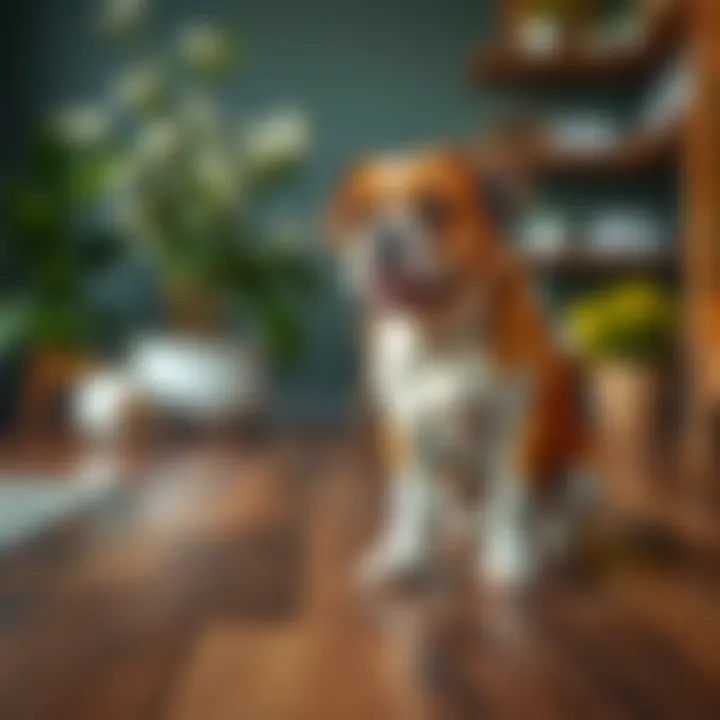
The distinctive characteristic of these visible signs is that they can often be treated with relatively straightforward solutions, making them a beneficial focus for your initial cleaning efforts. However, while they may easily disappear with some basic cleaning, failing to address the underlying issues—if any—may result in the odor scoring a comeback soon after your efforts.
Underneath the Surface Issues
Delving into underneath the surface issues often unveils an entirely different story. Hardwood floors, especially those installed over a subfloor, can harbor odors that are not apparent at first glance. This hidden damage can stem from urine that has seeped through cracks, crevices, or poor sealant that failed over time, impacting not just the surface but the integrity of the floor.
The unique aspect of these hidden issues is that they often require more specialized treatment or professional intervention, particularly if the subfloor has been affected. Not only does this type of damage tend to be challenging to detect, but it can also lead to mold growth and structural damage if left unaddressed. While the potential costs for repairing underneath surface issues can climb, the peace of mind in knowing you’ve tackled the problem correctly makes it worth the effort.
"An ounce of prevention is worth a pound of cure." Taking time for a thorough assessment makes the road ahead less bumpy.
Effective Cleaning Methods
In addressing pet urine odors from hardwood floors, proper cleaning methods are essential. It’s not just about getting rid of the smell; it’s also about preserving the integrity of the wood. Effective cleaning methods often yield two significant benefits: they ensure that unpleasant odors are eradicated and that the wood remains in good condition for the long haul.
Various techniques exist, from household remedies to commercial solutions, each offering specific advantages that can cater to different situations. Choosing the right method may depend on factors like the susceptibility of your floor type, the extent of the damage, and your preference for natural versus chemical solutions.
Using Enzymatic Cleaners
Enzymatic cleaners represent a specialized approach to dealing with pet urine stains. They contain enzymes that break down uric acid and other compounds found in pet waste, eliminating odors at the source instead of merely masking them. This doesn’t just make a surface smell nice; it actually targets the root of the problem.
A notable characteristic of these cleaners is their effectiveness on both new and old stains. When treating older stains that have settled deeply into the wood, enzymatic cleaners can often be the difference between completely removing the smell and just reducing it. Not every enzyme cleaner is created equal, though, so it's wise to read labels and look for products that specifically mention their efficacy on pet odors.
DIY Cleaning Solutions
Sometimes simple household items can work wonders. DIY cleaning solutions using baking soda, vinegar, or dish soap can often provide effective odor elimination at a lower cost, and these options are more accessible to many pet owners.
Baking Soda and Vinegar
Baking soda and vinegar is a combo that packs a punch against stubborn smells. Baking soda absorbs moisture and odor quite well, while vinegar acts as a natural disinfectant. When mixed, their chemical reaction helps lift stains from the surface of the wood.
A unique feature of this solution is its non-toxicity, making it a popular choice for pet owners. Because it doesn’t leave behind strong chemical residues, it is quite safety for use in homes with animals. Despite these advantages, it’s crucial to apply this method while following the proper ratio; too much vinegar can potentially harm the finish of your hardwood.
Dish Soap and Water
Using dish soap and water offers another alternative worth considering. The surfactants in dish soap help lift stains when used with warm water, making the cleaning process more effective. The soap breaks down oils and grime effectively and is relatively safe to use on hardwood floors.
One key characteristic of this DIY solution is its accessibility. Most households have dish soap readily available, making it an immediate solution for sudden accidents. However, it is necessary to rinse the area thoroughly afterward to prevent any residue from damaging the wood finish or attracting dirt.
Commercial Cleaning Products
In more severe cases, especially when dealing with persistent odors or significant staining, commercial cleaning products may be warranted.
Choosing the Right Brand
Brand selection is crucial in this category. Not all commercial cleaners are equally effective, and sometimes they can even cause damage. Brands that focus on eco-friendliness are often lauded for their efficacy combined with a gentler approach. It's essential to look for products that specify they are designed for hardwood floors and specifically target pet urine odors.
A distinct feature of trusted brands lies in their formulation. Many products now incorporate safe, biodegradable ingredients that still pack a powerful punch against stains. However, it’s vital to perform a patch test on a small, inconspicuous section of the floor before applying any new product thoroughly.
Application Techniques
The way in which you apply these products can also make a big difference in their effectiveness. Mist application is a popular method for ensuring an even spread without oversaturating the wood. It is essential to follow the manufacturer’s instructions precisely, as applying too much product can lead to water damage or finish deterioration.
In summary, cleaning methods vary widely, yet they all play an integral role in maintaining a fresh environment when it comes to pet odors on hardwood floors. From the natural solutions found in your pantry to specialized commercial products, understanding the strengths and weaknesses of each method is essential to achieving the desired outcome.
Preventing Future Incidents
Having a home with pets brings a whirlwind of joys, but it often comes hand in hand with challenges, especially concerning unpleasant odors on hardwood floors. Preventing future incidents of pet urine odor isn’t merely practical; it’s essential for maintaining a clean and pleasant living environment. By focusing on prevention, you can save time, effort, and money down the line, avoiding the extensive cleaning and potential damage that can occur when accidents happen.
A comprehensive approach to preventing urine mishaps involves behavioral training alongside strategically creating designated bathroom areas. Addressing these elements not only benefits your hardwood floors but fosters a solid bond with your pets, ensuring their comfort and security as well.
Behavioral Training for Pets
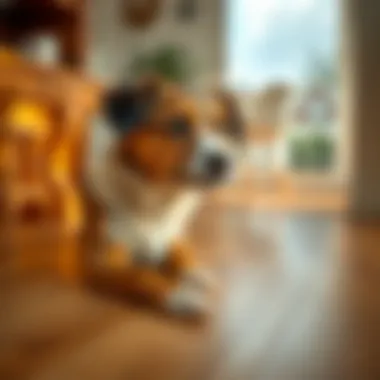

Effective training is the cornerstone of preventing pet-related issues. Establishing clear routines helps your fur friend understand what is expected of them. Training might take a bit of time and patience, but the fruits of your labor will surely make your living space smell fresher.
Establishing Routine
Creating a consistent bathroom schedule is vital in curtailing accidents. Pets thrive on repetitive behavior; when you establish a routine, they begin to associate specific times and places with bathroom activities.
A well-thought-out timetable aids in training your pet while allowing you to monitor their needs better. For example, feeding your dog at the same time daily may help you predict when they need to go outside. This predictability can minimize the chances of indoor accidents, keeping your hardwood in pristine condition.
- Key characteristics of establishing routine:
- Simplicity: It keeps things straightforward for your pet, making it easier for them to learn.
- Consistency: Regular schedules create habits, making the process smoother over time.
- Reliability: You gain insight into your pet's needs, leaving less room for errors in judgment.
Nevertheless, this approach demands commitment from you. Pets can break routines when unmonitored, leading to incidents that you worked hard to avoid. However, with persevering effort, this method will make your task much more manageable.
Positive Reinforcement Techniques
Motivating better behavior through positive reinforcement plays a pivotal role in making your home a more odour-free oasis. Rewarding your pet when they relieve themselves in the correct location helps reinforce that behavior, encouraging them to act appropriately in the future.
This technique is particularly effective because it builds trust and a positive emotional association for your pet between reinforcement and appropriate behavior.
- Key characteristics of positive reinforcement techniques:
- Encouragement: Positive reinforcement boosts your pet's confidence, leading to improved behaviour.
- Relationship-building: Strengthens your bond through trust and communication.
However, relying solely on this method might not yield instant results, especially if your pet has developed a habit of going indoors. Pairing it with other strategies, such as establishing routines, forms a more robust prevention plan.
Creating Designated Bathroom Areas
Designated bathroom spots specifically equipped for your pets can serve as an additional precaution against unpleasant smells. Not only do these areas provide a practical outlet for their bathroom needs, but they also aid in training. Selecting the right location, perhaps away from your pristine hardwood, can significantly minimize accidents.
In implementing this strategy, pay attention to the characteristics and needs of your pet. Some animals have instinctual preferences, like more hidden spots for privacy, while others may prefer open areas. Whatever their needs might be, ensuring they have a dedicated space to relieve themselves can bolster their comfort and reliability, steering both pet and owner clear of unforeseen incidents.
- Considerations for creating designated areas:
- Choose a location that is private yet accessible to your pet.
- Use specific ground coverings, such as artificial grass, to reinforce the outdoor equivalent.
- Regularly take your pet to their designated area, especially after meals or when they wake up.
By establishing a holistic approach to prevention, you not only protect your hardwood floors but also create an environment of trust and understanding with your pets. A bit of dedication on your part can go a long way toward making your home a pleasant space for everyone.
Floor Protection Strategies
To maintain the beauty and longevity of hardwood floors, which can be sensitive to moisture and stains, adopting effective floor protection strategies becomes essential. The goal here is to not only tackle any existing issues related to pet urine odor but also to safeguard your floors against future incidents. By implementing a multi-faceted approach that includes the application of protective sealants and the strategic use of area rugs, you create a robust defense against accidents that can lead to unwanted smells and potential damage.
Applying Sealants
Using sealants is one of the most effective methods for protecting hardwood floors from pet urine stains. Sealants act as a barrier, preventing moisture from seeping into the wood grain and causing damage.
Types of Sealants
There are primarily two types of sealants commonly used for hardwood floors: water-based and oil-based. Water-based sealants are favoured for their quick drying time and low odor, making them a practical choice for homes with pets. They tend to maintain the natural appearance of the wood. On the other hand, oil-based sealants provide a more robust layer of protection and are often considered more durable, but they take longer to dry and can have a pronounced scent during application.
Choosing the right sealant depends on your specific needs; for instance, if you're looking for safeguarding your floor against urine odors, a water-based option might be preferable due to its less aggressive chemicals. However, oil-based variants can provide superior resistance for heavy traffic areas. Each choice comes with its own advantages and disadvantages. If durability is your priority, oil-based sealants might win hands down, but if you’re looking for something that’s quick and low on fumes, water-based is the way to go.
Application Best Practices
When applying sealants, the process can significantly impact the outcome. A clean and dust-free surface is critical, and using the right applicator can make all the difference. A high-quality applicator pad can provide an even distribution, essential for a seamless finish.
Before applying, always consider doing a test patch to ensure compatibility with your floor type and to see if the sealant gives you the desired effect. Make sure to follow the manufacturer’s instructions diligently regarding drying times and re-coating, which are essential to ensuring that the protective layer bonds properly with the wood.
If done right, these practices not only enhance the appearance of your floors but also significantly extend their lifespan against wear from pets.
Using Area Rugs
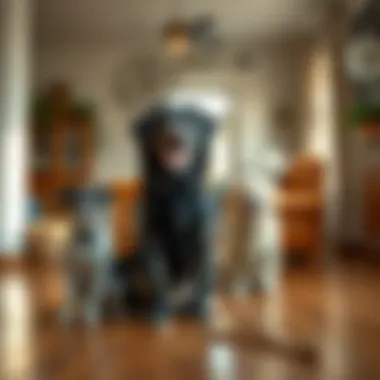
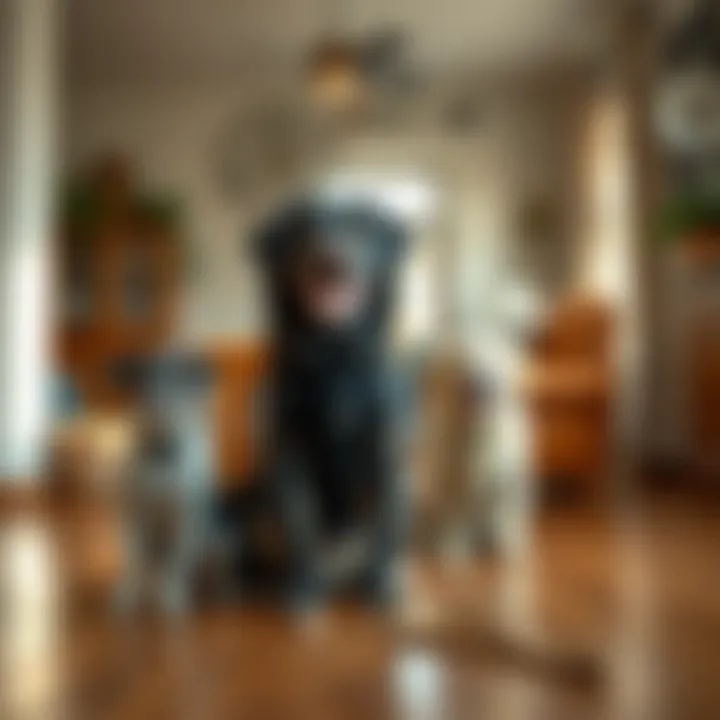
Area rugs can serve as an effective protective layer for hardwood floors. They act as a buffer that can catch spills and block accidents from pets, providing a simple yet effective layer of protection.
Selecting the Right Material
When it comes to selecting area rugs, consider materials that are both durable and easy to clean. Synthetic fibers, such as polypropylene and nylon, resist stains and are often machine washable, making them highly practical for pet owners. Conversely, natural fibers like wool or cotton might bring warmth and aesthetic appeal but could be more challenging to clean when faced with thorough accidents. When choosing, keep in mind the ease of maintenance alongside the rug's ability to withstand the wear and tear of pet activity.
Placement Strategies
Placement is crucial. Strategically positioning rugs in high-traffic areas, such as near doorways and in rooms where your pets spend the most time, can make a significant difference. Ensure that the rugs are well-anchored to avoid slips and trips, as pets play and run around. Additionally, consider large enough rugs that allow ample coverage, as this gives full protection to your hardwood floors, reducing the chance of exposure to potential accidents.
Employing effective floor protection strategies such as sealants and area rugs can mitigate risks associated with pet urine stains, helping you preserve both the value and beauty of your cherished hardwood floors. By taking these proactive measures, you create a harmonious balance between a pet-friendly environment and a beautiful home.
Long-Term Maintenance
Maintaining hardwood floors free from pet urine odors requires consistent effort. Long-term care can significantly reduce the chance of odors returning. This approach not only keeps the home smelling fresh but also ensures the longevity of the flooring itself. Understanding how to form and stick to effective routines can make all the difference in both appearance and hygiene.
Regular Cleaning Routines
Frequency of Cleaning
When it comes to frequency, staying on a disciplined cleaning schedule can be beneficial. Abrupt buildup of dirt, stains, or odors is mitigated when the floors are cleaned regularly. A routine might include cleaning once a week, especially in homes with multiple pets. This is often seen as a wise choice because it prevents the deeper penetration of odors and can save you from spending more time and money on intensive cleaning later. However, each home is unique, and some may need more frequent attention than others.
The unique feature of sticking to a consistent cleaning frequency is that it builds a habit. Once the routine is established, it becomes easier to maintain, requiring less effort to keep track. On the downside, if a cleaning plan is too aggressive, it may cause wear and tear on the hardwood, which is a delicate surface. So, finding a balance in frequency is essential.
Types of Cleaners to Use
Choosing the right type of cleaner is like picking the right tool for a job—it makes all the difference. While many solid options are out there, some pet owners prefer natural solutions like vinegar mixed with water. Others may opt for commercial cleaners designed specifically for pet odors. These also include enzymatic cleaners, which break down the urine components at a molecular level, eliminating the odor source effectively.
The standout characteristic of these cleaners is their composition. Natural solutions are often considered safer and more environmentally friendly, as they do not contain harsh chemicals. However, commercial cleaners frequently target tough stains and odors more effectively, saving time and effort. It is vital to read labels on any cleaner, ensuring it is suitable for hardwood floors to avoid damaging the surface.
Monitoring for Hidden Odors
Being vigilant about monitoring for hidden odors can prove invaluable in long-term maintenance. Sometimes pets urinate in spots that aren’t immediately visible. Under furniture or in corners can harbor surprises that lead to persistent unpleasant smells.
To catch these hidden traps, consider a monthly check in those hard-to-see areas. You might use a black light, which illuminates dried urine, uncovering any trouble spots. Regular inspection paired with deep cleaning can help in identifying any risks before they escalate. If you do discover hidden odors, swift action is critical, so you’ll want to have the understanding of how to address those untouched areas, preventing odor buildup from becoming a nightmare.
Consulting Professionals
When dealing with the pervasive issue of pet urine odor on hardwood floors, consulting professionals can be a game-changer. While many homeowners opt for DIY solutions, there's no denying that sometimes the situation calls for expert intervention. Whether concerning stubborn stains or lingering smells, professionals bring a wealth of experience that can effectively address chronic odor issues.
When to Call a Specialist
Understanding when to seek out the expertise of a specialist can save both time and headache. Here are some scenarios that indicate it's time to make that call:
- Persistent Odors: If you've applied various cleaning methods without success, that’s a clear red flag. Odors should not hang around for too long, and their stubborn presence could signal deeper issues.
- Severe Staining: When urine has seeped into the wood fibers or subflooring, it's likely created more than just a surface problem. Professionals can assess and address these hidden concerns.
- Allergic Reactions: If any members of your household are experiencing allergic reactions or sensitivities, a comprehensive cleaning and assessment by professionals can help eliminate not just the odor but any harmful bacteria as well.
- Preparing for Sale: If you plan to sell your home, having the floors professionally cleaned can boost appeal and demonstrate that you've taken good care of your space. Buyers are often keen on properties free of unpleasant odors.
What to Expect from Professional Services
Engaging a professional for cleaning pet urine from hardwood floors typically entails a few essential steps:
- Assessment of Damage: Initially, specialists will examine your floors for signs of damage, which could include discoloration, warping, or any structural issues.
- Customized Cleaning Plan: Based on their assessment, they will devise a tailored cleaning strategy suited to the severity of the situation and your specific type of flooring.
- Advanced Techniques: Many professionals use specialized equipment like steam cleaners or ozone generators. These tools can reach deep into the wood and effectively neutralize odors.
- Treatment Applications: After cleaning, they often apply sealants or odor-blocking agents to prevent future issues. This process not only offers immediate relief, but it also protects your investment.
- Ongoing Support: Post-cleaning, many professionals will provide tips on maintaining the cleanliness and longevity of your hardwood floors. This could include advice on preventative measures and regular maintenance schedules.
"Investing in professional cleaning may feel like splurging at first, but your hardwood floors—and the freshness of your home—are worth it."
By consulting with professionals, homeowners can ensure not only that the floors are cleaned effectively but also that the health of their indoor environment is safeguarded. This approach can give pet owners the peace of mind they need, knowing that they've taken the necessary steps for a lasting solution.
Closure
In wrapping up our exploration of pet urine odor removal from hardwood floors, it's vital to synthesize the knowledge we've gained throughout the article. The unfortunate truth is that pet accidents create a myriad of issues for homeowners. Addressing these odors not only improves the ambiance of the home but safeguards the integrity of hardwood flooring, ultimately preserving its aesthetic and monetary value.
Recap of Key Points
- Understanding the Problem: Grasping the chemistry behind pet urine helps in determining effective removal strategies. Knowing how urine interacts with wood enables targeted cleaning methods.
- Initial Assessment: Before diving headfirst into cleaning, identifying odor sources and weighing their extent prepares pet owners for informed actions.
- Effective Cleaning Methods: Utilizing enzymatic cleaners, DIY solutions, or commercial products each brings unique benefits and applicability. The choice heavily depends on the severity of the stain and personal preference.
- Preventing Future Incidents: Houses do not have to be a battleground against odors. Training pets and designating areas can reduce the likelihood of repeats.
- Floor Protection Strategies: Knowledge of sealants and rugs can provide an additional layer of defense against mishaps, making it easier to maintain a clean and welcoming home.
- Long-Term Maintenance: Regular cleaning routines and monitoring go a long way in safeguarding against lingering odors. Prevention is better than a cure when it comes to persistent smells.
- Consulting Professionals: Sometimes tackling the issue alone is daunting. Knowing when to seek professional help can make a significant difference in eradicating serious odors effectively.
Final Thoughts on Odor Management
Managing pet odors, particularly in homes with hardwood floors, is more than a chore; it’s a commitment to creating a healthy environment for both pets and humans. While the journey of odor elimination may seem like an uphill battle, it’s important to approach it practically and patiently. Key takeaways that resonate throughout this discussion point towards a balanced blend of maintenance, prevention, and suitable cleaning techniques. What’s essential is that every pet owner feels empowered to address these challenges as they arise. Remember, a clean and fresh home not only enhances your living space but also nurtures the bond with your furry companions. By arming yourself with the right knowledge and tools, you’re setting the stage for a harmonious coexistence in your beloved space.















